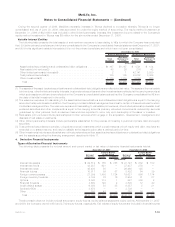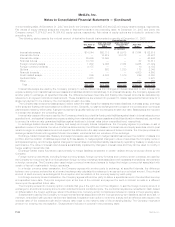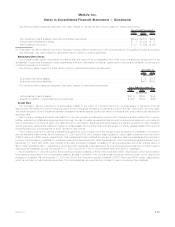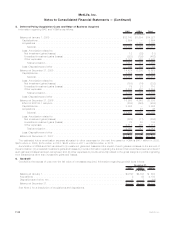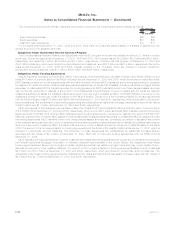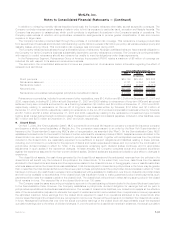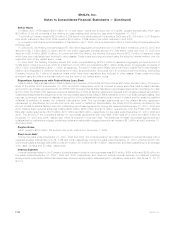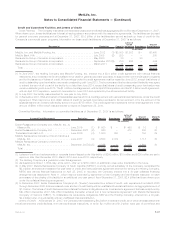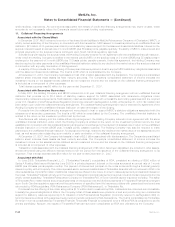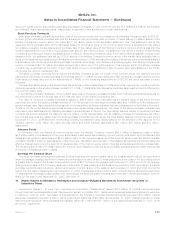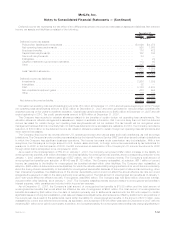MetLife 2007 Annual Report Download - page 139
Download and view the complete annual report
Please find page 139 of the 2007 MetLife annual report below. You can navigate through the pages in the report by either clicking on the pages listed below, or by using the keyword search tool below to find specific information within the annual report.
In addition to reinsuring mortality risk as described previously, the Company reinsures other risks, as well as specific coverages. The
Company routinely reinsures certain classes of risks in order to limit its exposure to particular travel, avocation and lifestyle hazards. The
Company has exposure to catastrophes, which could contribute to significant fluctuations in the Company’s results of operations. The
Company uses excess of retention and quota share reinsurance arrangements to provide greater diversification of risk and minimize
exposure to larger risks.
The Company had also protected itself through the purchase of combination risk coverage. This reinsurance coverage pooled risks
from several lines of business and included individual and group life claims in excess of $2 million per policy, as well as excess property and
casualty losses, among others. This combination risk coverage was commuted during 2005.
The Company reinsures its business through a diversified group of reinsurers. No single unaffiliated reinsurer has a material obligation to
the Company nor is the Company’s business substantially dependent upon any reinsurance contracts. The Company is contingently liable
with respect to ceded reinsurance should any reinsurer be unable to meet its obligations under these agreements.
In the Reinsurance Segment, Reinsurance Group of America, Incorporated (“RGA”) retains a maximum of $6 million of coverage per
individual life with respect to its assumed reinsurance business.
The amounts in the consolidated statements of income are presented net of reinsurance ceded. Information regarding the effect of
reinsurance is as follows:
2007 2006 2005
Years Ended December 31,
(In millions)
Directpremiums................................................... $24,168 $23,324 $22,232
Reinsuranceassumed ............................................... 6,181 5,294 4,646
Reinsuranceceded................................................. (2,454) (2,206) (2,018)
Netpremiums..................................................... $27,895 $26,412 $24,860
Reinsurance recoverables netted against policyholder benefits and claims . . . . . . . . . . . . . $ 2,622 $ 2,313 $ 2,400
Reinsurance recoverables, included in premiums and other receivables, were $10.4 billion and $10.2 billion at December 31, 2007 and
2006, respectively, including $1.2 billion at both December 31, 2007 and 2006 relating to reinsurance of long-term GICs and structured
settlement lump sum contracts accounted for as a financing transaction; $3.4 billion and $3.0 billion at December 31, 2007 and 2006,
respectively, relating to reinsurance on the run-off of long-term care business written by Travelers; $1.2 billion and $1.3 billion at
December 31, 2007 and 2006, respectively, relating to reinsurance on the run-off of workers compensation business written by Travelers;
and $1.1 billion and $1.4 billion at December 31, 2007 and 2006, respectively, relating to the reinsurance of investment-type contracts
held by small market defined benefit contribution plans. Reinsurance and ceded commissions payables, included in other liabilities, were
$571 million and $275 million at December 31, 2007 and 2006, respectively.
9. Closed Block
On April 7, 2000, (the “Demutualization Date”), MLIC converted from a mutual life insurance company to a stock life insurance company
and became a wholly-owned subsidiary of MetLife, Inc. The conversion was pursuant to an order by the New York Superintendent of
Insurance(the“Superintendent”)approvingMLIC’splanofreorganization,asamended(the“Plan”).OntheDemutualizationDate,MLIC
established a closed block for the benefit of holders of certain individual life insurance policies of MLIC. Assets have been allocated to the
closed block in an amount that has been determined to produce cash flows which, together with anticipated revenues from the policies
included in the closed block, are reasonably expected to be sufficient to support obligations and liabilities relating to these policies,
including, but not limited to, provisions for the payment of claims and certain expenses and taxes, and to provide for the continuation of
policyholder dividend scales in effect for 1999, if the experience underlying such dividend scales continues, and for appropriate
adjustments in such scales if the experience changes. At least annually, the Company compares actual and projected experience
against the experience assumed in the then-current dividend scales. Dividend scales are adjusted periodically to give effect to changes in
experience.
The closed block assets, the cash flows generated by the closed block assets and the anticipated revenues from the policies in the
closed block will benefit only the holders of the policies in the closed block. To the extent that, over time, cash flows from the assets
allocated to the closed block and claims and other experience related to the closed block are, in the aggregate, more or less favorable than
what was assumed when the closed block was established, total dividends paid to closed block policyholders in the future may be greater
than or less than the total dividends that would have been paid to these policyholders if the policyholder dividend scales in effect for 1999
had been continued. Any cash flows in excess of amounts assumed will be available for distribution over time to closed block policyholders
and will not be available to stockholders. If the closed block has insufficient funds to make guaranteed policy benefit payments, such
payments will be made from assets outside of the closed block. The closed block will continue in effect as long as any policy in the closed
block remains in-force. The expected life of the closed block is over 100 years.
The Company uses the same accounting principles to account for the participating policies included in the closed block as it used prior
to the Demutualization Date. However, the Company establishes a policyholder dividend obligation for earnings that will be paid to
policyholders as additional dividends as described below. The excess of closed block liabilities over closed block assets at the effective
date of the demutualization (adjusted to eliminate the impact of related amounts in accumulated other comprehensive income) represents
the estimated maximum future earnings from the closed block expected to result from operations attributed to the closed block after
income taxes. Earnings of the closed block are recognized in income over the period the policies and contracts in the closed block remain
in-force. Management believes that over time the actual cumulative earnings of the closed block will approximately equal the expected
cumulative earnings due to the effect of dividend changes. If, over the period the closed block remains in existence, the actual cumulative
F-43MetLife, Inc.
MetLife, Inc.
Notes to Consolidated Financial Statements — (Continued)


